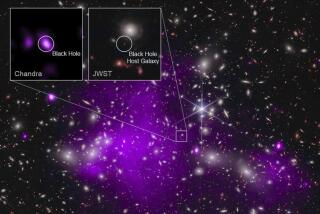Astronomers say former star is a nascent black hole
- Share via
A mysterious object that is eating interstellar gas and emitting X-rays in a telltale pattern is almost certainly a very young black hole — the first one people have been able to observe at such an early stage, scientists said Monday.
An amateur astronomer first spotted the object 31 years ago, when it was a star in the process of exploding into a supernova. Since then, the Chandra X-ray Observatory and other telescopes have documented that X-rays have been emitted from the former star at a surprisingly steady rate over a 12-year period from 1995 to 2007.
“If our interpretation is correct, then it’s the first time we’re seeing a black hole being born in a normal supernova,” said Harvard University astrophysicist Avi Loeb, who reported the discovery in the journal New Astronomy and described it during a NASA news conference.
The black hole — known as SN 1979C — is expected to give scientists a rare opportunity to track the evolution of one of the more bizarre phenomena in the cosmos. Black holes are regions of space where matter is so dense that nothing, not even light, can escape from them.
“It is in its infancy,” Kimberly Weaver, an astrophysicist at NASA’s Goddard Spaceflight Center in Greenbelt, Md., said at the news conference. “We want to watch how this system evolves and changes in its youthful stages, from when it’s first born to when it grows into a child and a teenager.” Weaver was not involved in the research.
Researchers think the black hole was created by a star that was 20 times more massive than our sun. Junior high school teacher Gus Johnson spotted it in 1979 when it was in its supernova stage. In its collapsed form, it now has five times more mass than the sun but is less than 25 miles across.
The black hole appears to have swallowed an Earth’s worth of mass in its short lifetime, Loeb said. At its current rate, it is set to double its mass in another 40 million years.
The black hole is situated a mere 50 million light-years away, in one of the Virgo galaxies. Finding a black hole so close to Earth is a rarity, Loeb added.
Loeb said he and his colleagues could not yet rule out the possibility that the object was actually a pulsar wind nebula, a gaseous cloud created by particles blown from a particular type of neutron star. However, he said the object was radiating energy at a rate that is far too bright for a typical pulsar wind nebula but is normal for a black hole.
Now that researchers know what X-ray signatures to look for, it will be much easier to scan the skies for more young black holes, Loeb said.







